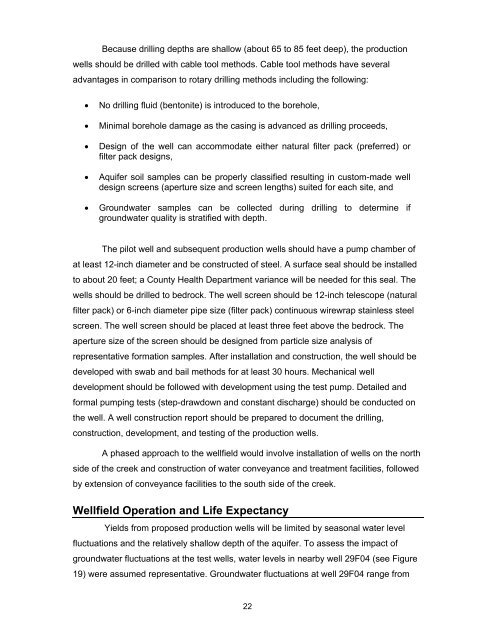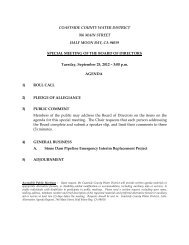Lower Pilarcitos Creek Groundwater Basin Study - Coastside ...
Lower Pilarcitos Creek Groundwater Basin Study - Coastside ...
Lower Pilarcitos Creek Groundwater Basin Study - Coastside ...
Create successful ePaper yourself
Turn your PDF publications into a flip-book with our unique Google optimized e-Paper software.
Because drilling depths are shallow (about 65 to 85 feet deep), the production<br />
wells should be drilled with cable tool methods. Cable tool methods have several<br />
advantages in comparison to rotary drilling methods including the following:<br />
• No drilling fluid (bentonite) is introduced to the borehole,<br />
• Minimal borehole damage as the casing is advanced as drilling proceeds,<br />
• Design of the well can accommodate either natural filter pack (preferred) or<br />
filter pack designs,<br />
• Aquifer soil samples can be properly classified resulting in custom-made well<br />
design screens (aperture size and screen lengths) suited for each site, and<br />
• <strong>Groundwater</strong> samples can be collected during drilling to determine if<br />
groundwater quality is stratified with depth.<br />
The pilot well and subsequent production wells should have a pump chamber of<br />
at least 12-inch diameter and be constructed of steel. A surface seal should be installed<br />
to about 20 feet; a County Health Department variance will be needed for this seal. The<br />
wells should be drilled to bedrock. The well screen should be 12-inch telescope (natural<br />
filter pack) or 6-inch diameter pipe size (filter pack) continuous wirewrap stainless steel<br />
screen. The well screen should be placed at least three feet above the bedrock. The<br />
aperture size of the screen should be designed from particle size analysis of<br />
representative formation samples. After installation and construction, the well should be<br />
developed with swab and bail methods for at least 30 hours. Mechanical well<br />
development should be followed with development using the test pump. Detailed and<br />
formal pumping tests (step-drawdown and constant discharge) should be conducted on<br />
the well. A well construction report should be prepared to document the drilling,<br />
construction, development, and testing of the production wells.<br />
A phased approach to the wellfield would involve installation of wells on the north<br />
side of the creek and construction of water conveyance and treatment facilities, followed<br />
by extension of conveyance facilities to the south side of the creek.<br />
Wellfield Operation and Life Expectancy<br />
Yields from proposed production wells will be limited by seasonal water level<br />
fluctuations and the relatively shallow depth of the aquifer. To assess the impact of<br />
groundwater fluctuations at the test wells, water levels in nearby well 29F04 (see Figure<br />
19) were assumed representative. <strong>Groundwater</strong> fluctuations at well 29F04 range from<br />
22



